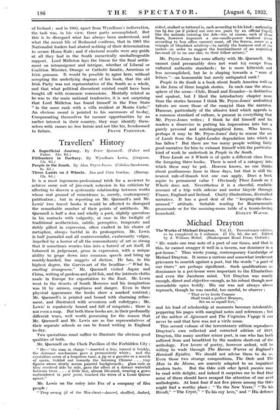Travellers' History
IT is a most ingenuous professional trick for a reviewer to achieve some sort of jim-crack cohesion in his criticism by
affecting to discern a systematic relationship between works whose real ground of coincidence is, merely, contemporary publication ; but in reporting on Mr. Quennell's and Mr.
Lewis' two travel -books it would be affected to disregard the remarkable number of their points of antithesis. Mr.
Quennell is half a don and wholly a poet, slightly querulous in his contacts with vulgarity, at ease in the twilight of traditional aestheticism, subtle, perceptive, temperate and richly gifted in expression, often exalted in his choice of metaphor, always tactful in its prolongation. Mr. Lewis is half journalist and all controversialist, exuberantly vulgar, impelled by a horror of all the concomitanty of art so strong that it sometimes worries him into a hatred of art itself, ill balanced in judgement, gross in expression, with a unique ability to grope down into common speech and bring up muddy-handed, fine nuggets of diction. He has, in the highest degree, the Garvin-art of the headline—" What ho, smelling strangeness." Mr. Quennell visited Japan and China, writing of gardens and gold fish, and the intricate cloths made in Europe for exportation to the East. Mr. Lewis went to the deserts of South Morocco and his imagination was lit by airmen, emptiness and danger. Even in their physical appearance the books show a marked contrast ; Mr. Quennell's is printed and bound with charming refine- ment, and illustrated with seventeen soft collotypes ; Mr. Lewis' is repulsively bound and full of misprints ; there is not even a map. But both these books are, in their profoundly different ways, well worth possessing for the reason that Mr. Quennell and Mr. Lewis are as fine representatives of their separate schools as can be found writing in England to-day.
Two quotations must suffice to illustrate the obvious good qualities of both.
Mr. Quennell on the Clock Pavilion of the Forbidden City :
"He—' the man in charge '—inserted a key, turned it briskly, the dormant mechanism gave a premonitory whirr ; and the crystalline notes of a forgotten time, a jig or a gavotte or a snatch of opera, tinkled out towards the listening Chinese . . . tiny figures swam slowly across painted backgrounds ; glass rods as they revolved side by side, gave the effect of a distant waterfall between trees a little boy, almost life-sized, wearing a gown embroidered in petit point, touched the wires of a Louis Quinze apinet."
Mr. Lewis on the entry into Fez of a company of film people :
" They swung (if of the Mix-class)---danced, shuffled, dashed,
Sidled, stalked or tottered in, each according to his kind : noticeably two by two as if picked out into sex pairs by an official Cupid) like the animals entering the Ark—for, of course, each of these Stars, however impotent a one-candle-power washout (even according to box office canons) must, off the Screen, move in a triangle of bloodshot adultery—to satisfy the business end of the racket—in order to suggest the bombardment of an anguished fan-mail (if to no one else, to their fellow actors)."
Mr. Pryce-Jones has some affinity with Mr. Quennell. He cannot (and presumably does not want to) escape from cultured authentic standards ; he is more kittenish and less accomplished, but he is shaping towards a "man of letters "—an honourable but surely antiquated rank !
People in the South is a book about South America written
in the form of three longish stories. In each case the atmo- sphere of the scene—Chile, Brazil and Ecuador—is distinctive
and opulent, but I liked the introductory chapter more than the stories because I think Mr. Pryce-Jones' undoubted talents are more those of the essayist than the narrator. Humour, particularly of the allusive kind which appeals to a common standard of culture, is present in everything that Mr. Pryce-Jones writes ; I think he did himself and his readers a disservice in putting his impressions into but a purely personal and autobiographical form. Who knows, perhaps it may be Mr. Pryce-Jones' duty to rescue the art of Lamb from the Light-Leader degradation into which it has fallen ? But there are too many people writing fairly good narrative for him to exhaust himself with the particular kind of work he undertook in People in the South.
Three Lands on 3 Wheels is of quite a different class from the foregoing three books. There is need of a category into which these may be put. Heaven knows, no one thinks about posthumous fame in these days, but that is still the nearest rule-of-thumb test one can apply. Does a book
aspire to permanent value ? Obviously Three Lands on 3 Wheels does not. Nevertheless it is a cheerful, readable
account of a trip with sidecar and motor bicycle through France, England and Ireland. Chatty illustrations, diversified narrative. It has a good deal of the " keeping-the-class- amused " attitude. Suitable reading for Bournemouth promenade or for the morning-room table of a tennis-loving


























 Previous page
Previous page